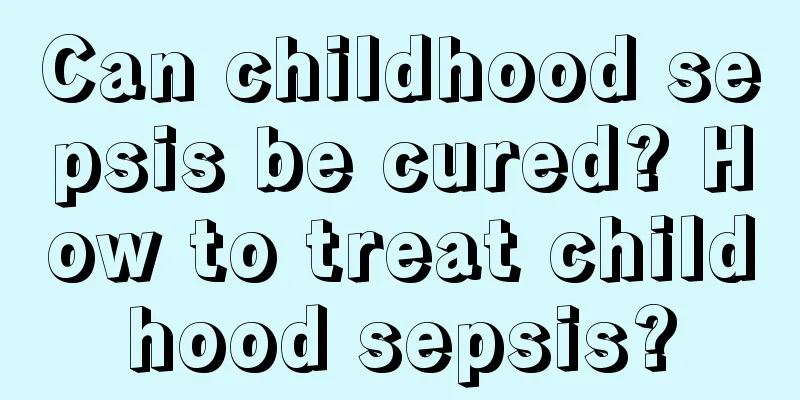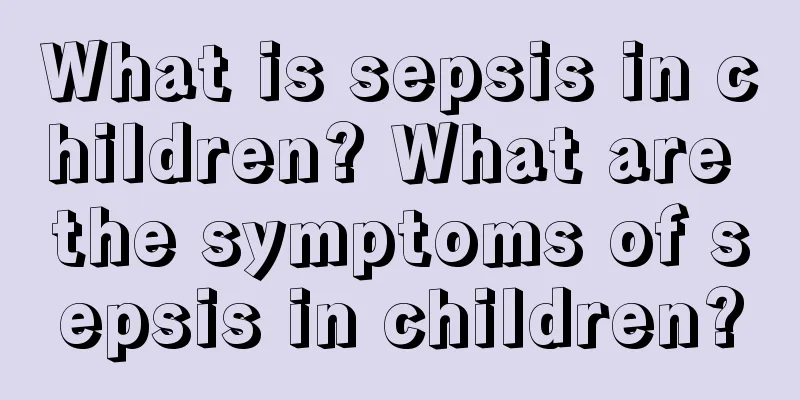Can childhood sepsis be cured? How to treat childhood sepsis?

|
Generally speaking, sepsis in children is quite serious, and many parents will be very worried about whether their children will have any problems, especially whether they can be cured. Next, let's take a look at whether sepsis in children can be cured? How is sepsis in children treated? Can sepsis in children be cured?If children with sepsis are older and have good nutritional status, they can be cured if they are given appropriate treatment as soon as possible. Generally speaking, the younger the age and the worse the nutritional status, the worse the prognosis. The key to treating sepsis is to completely eliminate the primary lesions and migratory lesions to eliminate the source of pathogenic bacteria, use effective antibiotics reasonably, eliminate all bacteria in the blood as soon as possible, detect new migratory lesions early, and completely eliminate them at any time, improve the body's resistance, and strengthen supportive therapy. How to treat sepsis in childrenSepsis mainly refers to a systemic disease caused by bacteria invading the blood and multiplying in the blood to produce toxins. Antibiotics are mainly used for treatment. Before the pathogen is identified, ampicillin plus penicillin are used first, and blood is drawn for testing and blood culture. After the results of the pathogen test come out, sensitive drugs are selected. The general course of treatment is about 10 to 14 days, and the patient is completely cured only after two negative blood cultures. At the same time, nutrition must be strengthened, and attention must be paid to diet. When necessary, ice globulin or immunoglobulin or drugs that increase immunity should be used for symptomatic treatment. How to check for sepsis in children1. Blood test. Generally, after this test, it can be found that the total white blood cell count will be significantly increased, and the percentage of neutrophils will also increase a lot. Even more than 80% of patients will have obvious nuclear left shift and intracellular toxic particles. There are also a small number of patients whose immune function is reduced, resulting in a normal or slightly low total white blood cell count. 2. Neutrophil tetrazolium blue test. This test is positive only when there is a bacterial infection, and more than 20% of patients will have this symptom. The results of this test can help distinguish viral infections from non-infectious diseases and bacterial infections. 3. Blood bacterial culture and drug sensitivity test. This test is also a common test item. For sepsis, the results obtained after the test can play an important role in diagnosing the disease. Is sepsis leukemia?Sepsis and leukemia are two different types of diseases and should not be confused. Sepsis is a disease that is mainly seen in departments such as infectious diseases, hematology, and critical care medicine. It is a systemic infectious disease caused by conditional pathogens that circulate in the blood; while leukemia is a disease caused by abnormal clonal proliferation of hematopoietic stem cells, and patients may have a large number of leukemia cells. Leukemia is a blood tumor that may be related to factors such as genetics and gene mutations. |
>>: Can children with anemia eat donkey-hide gelatin? Can children with anemia get vaccinations?
Recommend
What should I do if my baby always wakes up during sleep? How to improve my baby's sleep
It is very difficult for parents to coax their ba...
Typical symptoms of childhood phobias and the dangers of childhood phobias
Childhood phobia refers to a strong and unwilling...
Can pregnant women eat cold dishes? Eat less cold dishes outside
The weather is hot now, and many people like to e...
What clothes should babies wear after the beginning of autumn? Do babies need to wear socks after the beginning of autumn?
What clothes should babies wear after the Beginni...
How to choose a private kindergarten for your child?
When children reach the age to go to kindergarten...
Can babies eat dried shrimps? Is it good for babies to eat dried shrimps?
Babies are curious about food and it is up to the...
How to avoid accidents when children get lost in shopping malls
This year, babies are often lost in shopping mall...
Can I use skin care products during postpartum breastfeeding? Can I use my previous skin care products after giving birth?
Many mothers who have given birth are confused ab...
How to understand children's personality from their blood type and teach them in accordance with their aptitude
Every child has his or her own unique personality...
It is not easy for female stars to get pregnant quickly.
There have been many happy events of pregnancy an...
How to massage a baby when he has a fever? Massaging acupoints when a baby has a fever is effective in reducing fever
Babies generally have poor immunity and are prone...
Can pregnant women eat plums? What are the benefits of eating plums in moderation for pregnant women?
Plums are appetizers and aid digestion. They are ...
What are the benefits of prenatal education? In which month can pregnant women do prenatal education?
Do you know about prenatal education in your life...
The disadvantages of children not liking to drink water. What should I do if my baby doesn’t like to drink water in summer?
Summer is here, and many babies sweat a lot when ...
What is Hypnobirthing? What are the benefits of Hypnobirthing?
What is medical hypnobirthing? It stabilizes the ...









